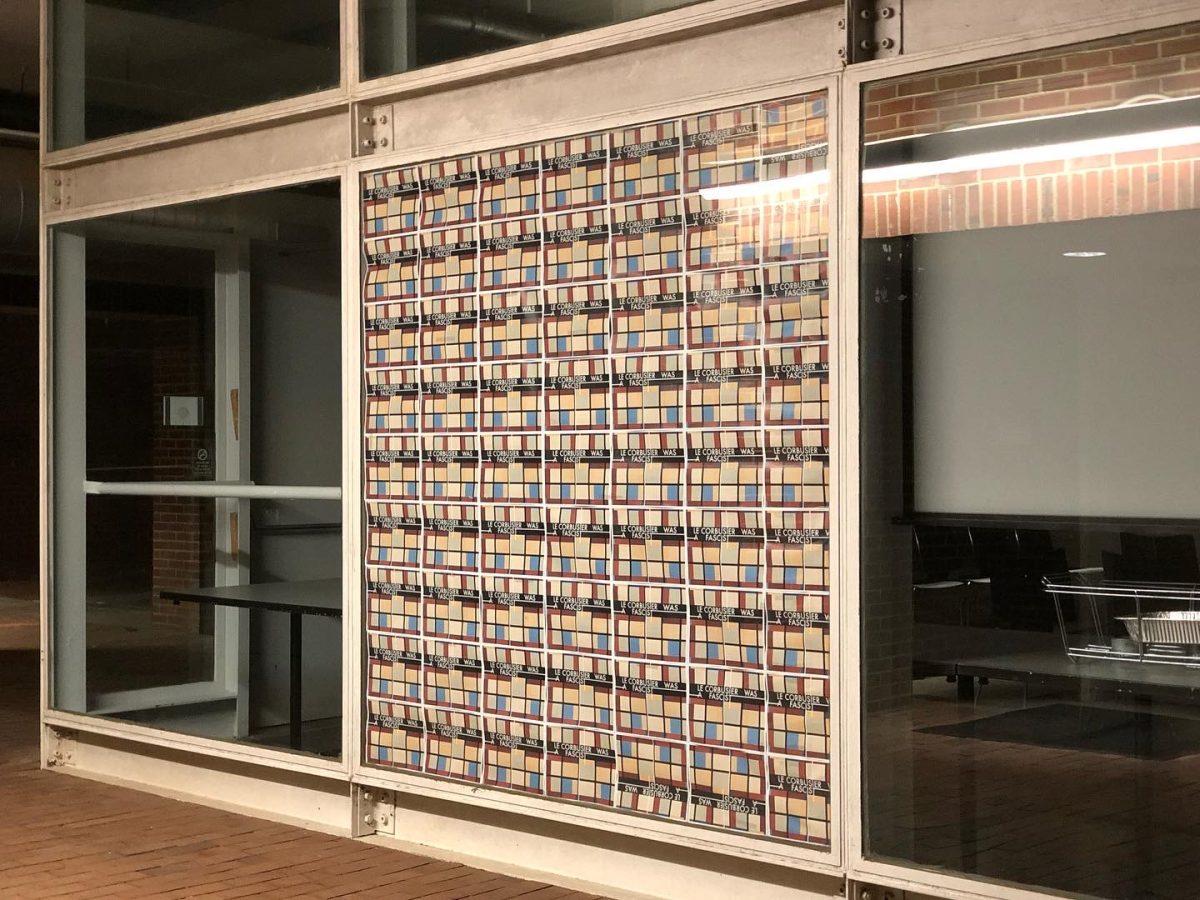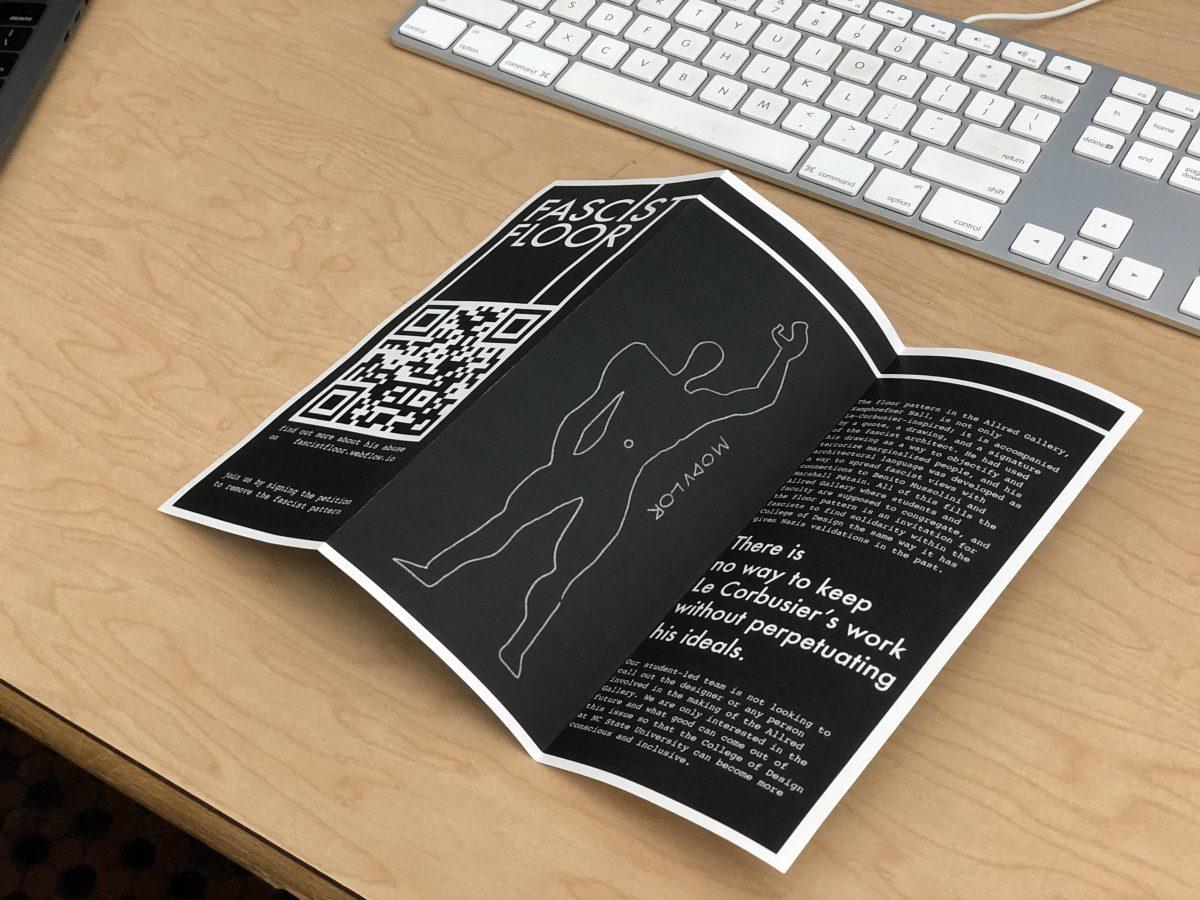With support from the design school’s administration, a team of students is petitioning to replace a floor in the Allred Gallery in Kamphoefner Hall which is inspired by fascist architect Le Corbusier.
This issue was first made known when Sea Tong Veng, a fourth-year studying environmental design in architecture, learned about Le Corbusier in class and decided to do his own research.
“There’s a class that we all have to take as architecture students, and it’s about contemporary theory and architecture,” Veng said. “That’s sort of like the introduction into Le Corbusier being a terrible human being. But we didn’t really say anything about his involvement with fascist movements and him being a Nazi or anything. And so I just sort of did my own research, which wasn’t even hard to find at all.”
Veng said he was surprised there was a floor pattern inspired by Le Corbusier without any mention of his involvement in fascism.
“I’ve never heard anyone talking about him being a fascist,” Veng said. “That sort of blew me away, and I couldn’t believe it, and I wanted to say something about it. I just feel like as an institution, having a room dedicated to fascist figures, [is] sort of like lowkey glorifying fascism. I don’t think that that’s right.”
Veng decided to create posters and pamphlets that would inform others about the situation and refer them to the website and petition he created. He said he received some backlash and another student created counter posters, one of which was placed on his studio desk.
“It was a little scary, and I didn’t want to expose myself,” Veng said. “And in the meantime, I was trying to talk to close friends and see if they’re interested in starting a team.”
Veng said after the issue began circulating within the college, the dean of the College of Design, Mark Hoversten, set up a meeting with the students and some other faculty members.
“At the end of the meeting, they were all on board with us,” Veng said. “No one in the faculty denied his involvement with fascism, which was great. A lot of the backlash that we got is mostly from students.”
Before meeting with the students, David Hill, the head of the architecture school, said he noticed the flyers around campus and spoke with Burak Erdim, an associate professor of architecture.
“I remember Burak and I saying to one another, ‘This is kind of interesting. Do you know who’s bringing this up?’ Because it was anonymous,” Hill said. “As designers will do, they designed very beautiful flyers that caught our attention.”
Erdim said he was thrilled to see the flyers because of the important conversation that could come from discussing this issue.
“This is the very thing that we talk about in our classes at the school, and to see the students actually apply what they’re learning in the classroom, to look at the environment around them; where else would you start but the very school that you’re in?” Erdim said. “It was really kind of wonderful to see that.”
Erdim decided to open one of his weekly graduate-level discussion sessions up to the undergrads to discuss Le Corbusier, and the session was even held in the Allred Gallery. Veng said these discussions are important because a lot of students didn’t have much information about Le Corbusier before.
Erdim said it is important to find a balance when discussing Le Corbusier as an architect and as a person because he was so influential to modern architecture.
“So much of the architectural establishment viewed Corbusier as one of the most influential and prolific figures of the 20th century, so his work was seen as exemplary and canonical,” Erdim said. “The students are aware that Corbusier is an influential figure. What they’re asking for about these types of canonical figures right now, is a kind of a recontextualization of their work within the social and political context which they’re coming from. So if we are teaching Corbusier, we kind of provide this enigmatic background and the multiple aspects of it.”
Mark Hoversten, dean of the College of Design, said following the initial meeting with the students last semester, they plan to reconvene again this semester to plan the future of the gallery floor.
“One of the things we try to do is empower our students, and so we’re going to get our students back together for what we call a charette, which is a short intense workshop,” Hoversten said. “It’s a very common thing that we do in the design disciplines. … We will review this context about how we’re learning about designers as multidimensional people.”
Hoversten said there are many ways they could handle the redesigning of the floor, and they want to discuss those with the students as well.
“We’ll talk about, ‘Well, what should we do?’” Hoversten said. “There are probably several options, because as designers, we like to open up the options before we make decisions. And then we’ll figure out, ‘Should we use this as an exhibit? As a way of talking about this very issue? Should we be covering it up? What are the different options?’”
The students will be able to use the design process, Hoversten said, to make a real impact on the issue they’ve raised.
“It’s another way of taking [a] history class and actually applying it in a broader sense in a real life situation, and seeing what happens,” Hoversten said. “We’re going to use it as an educational moment.”
Hill said he thinks it is important to problem solve as a group in order to appeal to all people.
“As designers, we seek to engage a broader range of stakeholders, and we think that doing that will allow us to gather opinions and thoughts and to have empathy in ways that maybe designers in the past did not,” Hill said.
Veng said this issue is important to him because students should have a say in the spaces they occupy.
“I study architecture, [so] I’m a little more sensitive to spaces, but I think a lot of people don’t have a say in the spaces that they’re in, and I feel like that should change,” Veng said.
Hill said the faculty’s job is to support the students and listen to their concerns.
“I think one thing we always say here is ‘The students are why we’re here,’” Hill said. “I think it’s really important that we listen to our students, and that they listen to us as well. And that there is a back and forth, there is a scholarly debate. But there’s also a level of care that we have for one another in sort of cultivating a community of good design, but also of just wonderful interaction.”














